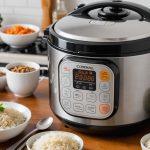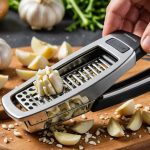Creating a raw food kitchen in a health-focused restaurant demands the right tools and appliances to ensure efficiency, quality, and creativity. Essential devices not only elevate preparation but also enhance the vibrant flavors and nutritional benefits of raw ingredients. From high-performance blenders to spiralizers, each tool plays a pivotal role in creating delicious and wholesome dishes. Discover how these key appliances can transform your culinary experience while supporting your commitment to health and wellness.
Essential Tools for a Raw Food Kitchen
Having the right raw food kitchen tools is crucial for anyone passionate about raw food preparation.
In the same genre : Discover unique ingredients to create unforgettable ice cream flavors at your dessert bar!
Overview and Importance
A well-equipped raw food kitchen requires specific kitchen essentials. These tools not only simplify the process but also enhance the quality of the dishes. Important tools include a high-speed blender, which is indispensable for creating smoothies, soups, and sauces. A food processor is another must-have, perfect for chopping, slicing, and dicing ingredients efficiently.
Functionality of Each Tool
- High-Speed Blender: Essential for smooth textures.
- Food Processor: Ideal for chopping and mixing.
- Dehydrator: Useful for drying fruits and vegetables.
- Spiralizer: Creates vegetable noodles for raw pasta dishes.
Tips for Selecting High-Quality Kitchen Tools
When choosing food preparation tools, consider durability and ease of use. Look for stainless steel options for longevity. A good warranty can also indicate the manufacturer's confidence in their product.
In the same genre : Elevate your café atmosphere: innovative ways to integrate local artists” artwork into your décor
"Invest in quality tools; they save time and enhance your culinary creations."
By selecting the right tools, you can ensure your raw food kitchen is efficient and enjoyable to use.
Appliances That Enhance Raw Food Preparation
Incorporating the right raw food appliances can significantly elevate your culinary experience, making food preparation and preservation more efficient.
Must-Have Appliances
- High-Speed Blender: Perfect for creating smooth textures in smoothies and sauces.
- Food Processor: Efficient for chopping and mixing ingredients quickly.
- Dehydrator: Ideal for preserving fruits and vegetables by removing moisture while retaining nutrients.
- Juicer: Extracts fresh juice, providing a nutrient-rich beverage.
Benefits of Each Appliance
Each kitchen appliance offers unique advantages. A high-speed blender ensures a silky finish, crucial for raw soups. Food processors save time with their versatile functions. Dehydrators extend the shelf life of produce, making them essential for food preservation. Juicers provide a convenient way to consume a variety of fruits and vegetables, boosting your nutrient intake.
Recommendations for Brands and Models
Selecting reliable food processing machines is vital. Brands like Vitamix and Cuisinart are known for their durability and efficiency. Consider models with robust warranties and positive user reviews to ensure quality and longevity.
"Investing in quality appliances enhances not just the food but the entire preparation process."
By choosing the right appliances, you can make raw food preparation both enjoyable and efficient.
Storage Solutions for Raw Ingredients
Ensuring the freshness and quality of raw ingredients is essential for any raw food enthusiast. Proper food storage techniques can significantly enhance the shelf life and nutritional value of your ingredients.
Importance of Proper Storage
Proper storage of raw ingredients is crucial for maintaining their nutritional integrity. Without adequate food storage, ingredients can quickly spoil, leading to waste and loss of vital nutrients. This is particularly important in a raw food kitchen where freshness is paramount.
Types of Storage Solutions
Different storage solutions cater to various ingredient preservation needs. Consider using:
- Airtight Containers: Ideal for nuts, seeds, and dried fruits.
- Glass Jars: Perfect for storing fresh herbs and spices.
- Vacuum Sealing: Extends the shelf life of fresh produce by reducing exposure to air.
Best Practices for Organizing and Maintaining Freshness
To maximize the effectiveness of your raw food storage, follow these best practices:
- Label containers with purchase dates.
- Store produce in cool, dry places.
- Rotate stock to use older items first.
"Proper storage is the key to preserving the life and vitality of your raw ingredients."
By implementing these ingredient preservation strategies, you can ensure your raw food kitchen remains efficient and your ingredients stay fresh.
Preparation Techniques for Raw Food
Understanding the art of raw food techniques can transform your culinary experience.
Common Preparation Techniques
Raw food cuisine often employs food preparation methods such as soaking, sprouting, and fermenting. These methods enhance the nutritional value and digestibility of ingredients. Soaking nuts and seeds, for instance, removes enzyme inhibitors, making them easier to digest. Sprouting grains and legumes increases their nutrient content, while fermenting vegetables like cabbage creates probiotic-rich dishes such as sauerkraut.
Step-by-Step Methods for Popular Raw Dishes
Creating raw recipes requires precision and patience. Here’s a simple guide for a raw zucchini pasta:
- Spiralize zucchini into noodles.
- Blend tomatoes, basil, and garlic for a fresh sauce.
- Toss noodles with sauce and garnish with nuts.
This method highlights the simplicity and flavor of raw meals.
Tips for Maximizing Flavor and Nutrition
To enhance the taste and nutritional profile of raw meals, consider these tips:
- Use fresh, organic ingredients.
- Balance flavors with herbs and spices.
- Experiment with textures by combining crunchy and creamy elements.
"The secret to vibrant raw recipes lies in the freshness and quality of ingredients."
By mastering these food preparation methods, you can create delicious and nutrient-rich dishes.
Sourcing High-Quality Ingredients
Elevate your raw food dishes with the finest ingredients.
Importance of Sourcing Organic and Fresh Ingredients
Sourcing organic and fresh ingredients is crucial for maintaining the nutritional value and taste of raw food dishes. Organic produce is free from harmful pesticides and chemicals, ensuring that the food you prepare is not only healthy but also flavorful. Prioritizing fresh ingredients enhances the overall quality of your meals, making them more vibrant and enjoyable.
Where to Find High-Quality Raw Food Ingredients
Finding top-notch raw food ingredients can sometimes be challenging. Local farmers' markets are excellent places to start, offering a variety of organic and fresh produce. Natural food stores and co-ops also provide a wide selection of organic products. Building a network of reliable suppliers can ensure a consistent supply of high-quality ingredients.
Building Relationships with Local Farmers and Suppliers
Establishing strong relationships with local farmers and suppliers can significantly benefit your raw food kitchen. By engaging directly with these sources, you can gain insights into the sourcing practices and ensure the freshness of your ingredients. Consider visiting farms and participating in community-supported agriculture (CSA) programs to deepen these connections.
"The key to exceptional raw food lies in the quality of the ingredients you choose."
Nutritional Considerations in Raw Food
Exploring the nutritional landscape of raw food diets.
Overview of Nutritional Benefits
A raw food diet offers numerous health benefits, primarily due to its emphasis on fresh and natural ingredients. This dietary approach is rich in vitamins, minerals, and enzymes, which are often diminished in cooked foods. By consuming raw foods, you can enhance your intake of essential nutrients, leading to improved digestion and increased energy levels.
Essential Nutrients in Raw Food Preparation
To maximize the benefits of a raw food diet, it's important to focus on obtaining essential nutrients. Key nutrients include:
- Vitamins A, C, and E: Found in fruits and vegetables, these vitamins are vital for immune function and skin health.
- Omega-3 Fatty Acids: Present in flaxseeds and walnuts, these are crucial for heart health.
- Iron and Calcium: Leafy greens and nuts provide these minerals, supporting bone health and oxygen transport.
Balancing Raw Meals with Other Dietary Needs
Balancing your raw food nutrition with other dietary needs ensures a comprehensive and healthy diet. Consider incorporating:
- Protein Sources: Nuts, seeds, and legumes.
- Whole Grains: Quinoa and buckwheat for added fiber.
- Healthy Fats: Avocados and coconut for energy and satiety.
"A balanced raw diet requires thoughtful planning to meet all nutritional needs."
Equipment Maintenance and Care
Ensuring the longevity and efficiency of your kitchen tools.
Best Practices for Kitchen Equipment Care
Regular kitchen equipment care is essential to maintain functionality and longevity. Begin by cleaning tools and appliances after each use. Use mild detergents and avoid abrasive materials that can damage surfaces. For appliance maintenance, check manufacturer guidelines for specific cleaning instructions.
Importance of Regular Cleaning and Upkeep
Routine cleaning prevents build-up that can impair performance. For instance, food particles left in a food processor can dull blades over time. Regular tool upkeep not only extends the life of your equipment but also ensures optimal performance.
Troubleshooting Common Issues
Even with proper care, issues may arise. Here’s a quick guide to troubleshooting:
- Blender not starting: Check power source and blade assembly.
- Dehydrator uneven drying: Rotate trays for even air circulation.
- Juicer clogging: Clean filters thoroughly and avoid overloading.
"Consistent maintenance is the key to preserving the efficiency of your kitchen equipment."
By adhering to these kitchen equipment care practices, you ensure your tools and appliances remain in top condition, supporting your raw food preparation needs.
Incorporating Raw Foods into a Health-Focused Menu
Crafting a raw food menu that attracts health-conscious diners requires strategic planning.
Strategies for Integration
To seamlessly integrate raw food items into a restaurant menu, start with versatile dishes that can complement existing offerings. Consider adding a raw food menu section to highlight these options. Collaborate with chefs to innovate traditional dishes by incorporating raw elements, such as raw zucchini pasta or fresh fruit salads.
Popular Raw Dishes
Health-conscious diners often seek specific raw dishes that are both nutritious and appealing. Popular choices include:
- Raw Vegan Tacos: Made with walnut meat and fresh vegetables.
- Zucchini Noodles: Tossed with avocado pesto.
- Chia Seed Pudding: A breakfast favorite with almond milk and berries.
Marketing Tips
Promoting raw food offerings effectively can boost their popularity. Use engaging visuals and detailed descriptions on menus to entice diners. Highlight the health benefits of each dish, such as improved digestion and increased energy. Consider hosting tasting events or workshops to educate customers about the advantages of a raw food menu.
"Incorporating raw foods into your menu not only diversifies offerings but also attracts a growing market of health-conscious consumers."












